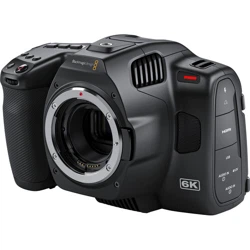Loading ...
Loading ...
Loading ...

Embedded 3D LUTs
When a 3D LUT is used while shooting Blackmagic RAW on Blackmagic Pocket Cinema
Camera, the selected LUT will be embedded into the Blackmagic RAW file that you are
recording. The 3D LUT is actually saved with your recorded files in the header of the .braw file,
and can easily be applied to footage in post production without needing to handle a
separate file.
So when Blackmagic RAW files are delivered to an editor or colorist, they will be able to easily
access the LUT that was used while filming, which greatly reduces the possibility that the wrong
3D LUT could be applied to a clip. They can then choose whether to apply the 3D LUT when
editing or color grading the footage, and can disable the 3D LUT at any time.
When the ‘apply LUT in file’ switch is set to ‘on’ in the record menu, the recorded clip will open
in Blackmagic RAW Player and DaVinci Resolve with the chosen 3D LUT already applied to it.
The 3D LUT can then be easily toggled ‘on’ or ‘off’ but will always travel with the Blackmagic
RAW file as it is written into the clip itself. DaVinci Resolve also has an ‘Apply LUT’ switch in the
RAW settings palette for enabling or disabling the 3D LUT in the Blackmagic RAW file.
The ‘Apply LUT’ setting in DaVinci Resolve is the same setting as in the camera. This means that
when shooting you can direct the colorist to use the LUT by setting it in the camera, but they
can switch it off easily in DaVinci Resolve by setting ‘Apply LUT’ to ‘off’.
Entering Metadata
Metadata is information saved inside your clip, such as take numbers, camera settings and
other identifying details. This is extremely useful when sorting and processing footage in
postproduction. For example, take, shot and scene numbers are essential organisational tools,
while lens information can be used to automatically remove distortion or better match
VFXassets to plates.
Your Blackmagic Pocket Cinema Camera automatically saves some metadata to each clip, such
as camera settings, timecode, date and time. You can use your camera’s slate to add many
additional details.
Slate
Swipe left or right on your camera’s touchscreen from the main view to bring up the slate.
The slate is divided into ‘clip’ and ‘project’ tabs. The ‘clip’ tab contains information that may vary
clip by clip, while ‘project’ is where you enter details common between clips, such as the
project name, director, and camera and operator ID.
TIP Metadata entered into the slate is viewable on the HDMI output when ‘display
status text for’ is set to ‘director’ on the ‘monitor’ tab. See the ‘monitor settings’ section
in this manualfor more information.
‘Clip’ metadata
Making changes to clip metadata works differently in standby mode to playback mode. In
standby mode, when your camera is ready to record, clip metadata gets saved to the next clip
recorded, except the ‘good take last clip’ button applies a ‘good take’ tag to the most recently
recorded clip. In playback mode, when you are reviewing footage already shot, the ‘good take’
button is shown and clip metadata is always attached to the current clip being viewed.
92Entering Metadata
Loading ...
Loading ...
Loading ...
